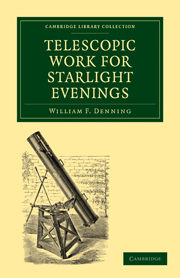Book contents
- Frontmatter
- PREFACE
- Contents
- ILLUSTRATIONS
- CHAPTER I THE TELESCOPE, ITS INVENTION AND THE DEVELOPMENT OF ITS POWERS
- CHAPTER II RELATIVE MERITS OF LARGE AND SMALL TELESCOPES
- CHAPTER III NOTES ON TELESCOPES AND THEIR ACCESSORIES
- CHAPTER IV NOTES ON TELESCOPIC WORK
- CHAPTER V THE SUN
- CHAPTER VI THE MOON
- CHAPTER VII MERCURY
- CHAPTER VIII VENUS
- CHAPTER IX MARS
- CHAPTER X THE PLANETOIDS
- CHAPTER XI JUPITER
- CHAPTER XII SATURN
- CHAPTER XIII URANUS AND NEPTUNE
- CHAPTER XIV COMETS AND COMET-SEEKING
- CHAPTER XV METEORS AND METEORIC OBSERVATIONS
- CHAPTER XVI THE STARS
- CHAPTER XVII NEBULÆ AND CLUSTERS OF STARS
- NOTES AND ADDITIONS
- INDEX
- Plate section
CHAPTER XI - JUPITER
Published online by Cambridge University Press: 05 July 2011
- Frontmatter
- PREFACE
- Contents
- ILLUSTRATIONS
- CHAPTER I THE TELESCOPE, ITS INVENTION AND THE DEVELOPMENT OF ITS POWERS
- CHAPTER II RELATIVE MERITS OF LARGE AND SMALL TELESCOPES
- CHAPTER III NOTES ON TELESCOPES AND THEIR ACCESSORIES
- CHAPTER IV NOTES ON TELESCOPIC WORK
- CHAPTER V THE SUN
- CHAPTER VI THE MOON
- CHAPTER VII MERCURY
- CHAPTER VIII VENUS
- CHAPTER IX MARS
- CHAPTER X THE PLANETOIDS
- CHAPTER XI JUPITER
- CHAPTER XII SATURN
- CHAPTER XIII URANUS AND NEPTUNE
- CHAPTER XIV COMETS AND COMET-SEEKING
- CHAPTER XV METEORS AND METEORIC OBSERVATIONS
- CHAPTER XVI THE STARS
- CHAPTER XVII NEBULÆ AND CLUSTERS OF STARS
- NOTES AND ADDITIONS
- INDEX
- Plate section
Summary
“Beyond the sphere of Mars, in distant skies,
Revolves the mighty magnitude of Jove,
With kingly state, the rival of the Sun.”
Of all the planets, Jupiter is the most interesting for study by the amateur. It is true that Saturn forms an exquisite object, and that his wonderful ring-system is well calculated to incite admiration as a feature unique in the solar system. But when the two planets come to be repeatedly observed, and the charm of first impressions has worn away, the observer must admit that Jupiter, with his broad disk and constantly changing markings, affords the materials for prolonged study and sustained interest. With Saturn the case is different. His features are apparently quiescent; usually there are no definite spots upon the belts or rings. There is a sameness in the telescopic views; and this ultimately leads to a feeling of monotony, which causes the object to be neglected in favour of another where active changes are in visible progress.
Brightness and Position.—Jupiter is a brilliant object in the heavens, his lustre exceeding that of Mars or Saturn, though not equal to that of Venus. I have occasionally seen the planet with the naked eye in the daytime, about half an hour after sunrise; and it has been frequently observed by Bond, in America, with the Sun at a considerable altitude. Humboldt and Bonpland, at Cumana, 10° N. lat., saw Jupiter distinctly with the naked eye, 18 minutes after the Sun had appeared in the horizon, on Sept. 26, 1830.
- Type
- Chapter
- Information
- Telescopic Work for Starlight Evenings , pp. 170 - 194Publisher: Cambridge University PressPrint publication year: 2010First published in: 1891



